Abstract
This study aimed to investigate the effect of freeze and thaw (FT) cycles on the performance of asphalt concrete (AC) mixtures modified by partial replacement of mineral filler of the aggregate with natural bentonite clay (NBC) in order to reduce damage that occurs due to rapid FT cycles within the pavement structure. After exposure to FT cycles, AC mixture stability is reduced and becomes lower than minimum requirements, which leads to earlier damage of pavement. In order to enhance the AC mixture’s abilities to sustain severe FT cycles, this study used NBC amounts as a substitute for mineral filler by weight of its portion of the total aggregate: 5%, 10%, 15%, and 20%. Marshall stability, flow, and FT cycles were tested, and interior damage degree was assessed by a nondestructive test called ultrasonic pulse velocity (UPV). The results revealed the viability of combining NBC with asphalt mixtures for the purpose of improving the mixtures’ properties, particularly in environments where asphalt pavement is exposed to alternating FT cycles. The results also revealed that replacement of filler with NBC by 5% in AC mixtures reduced the damage caused over 8 continuous weeks of rapid FT cycles by 13%, which, in future applications, would reduce maintenance cost and prolong the pavement’s service life.
1. Introduction
Asphalt pavements can withstand substantial loads and environmental conditions for a reasonable time [1]. Various forms of admixtures have been used to prolong the serviceability life of pavements by alleviating temperature effect and cracking of asphalt concrete (AC) mixtures [2,3]. Numerous studies have shown that in this use, fiber, hydrated lime, waste plastics, and traditional polymers could develop properties of AC [4,5]. However, high-temperature stability and low-temperature cracking-resistance requirements could not be satisfied for many asphalt and improved AC mixes [6]. Therefore, new admixtures were investigated in order to improve the performance of AC mixtures: for example, nano-clay. These improved mixes were found to show better rutting resistance than traditional AC pavements (without additives), according to AASHTO T283 [7]. The high surface area of nano-clay (700–800 m2/g) is due to the separation of clay discs, which creates an interface between nano-clay and asphalt. Nano-particles, nano-silica, nano-tubes, and bentonite clay were suggested to be added to the AC mix to raise the viscosity of binders and to enhance rutting and fatigue resistance [8,9]. Fillers were principally categorized by capacity to stiffen and thicken asphalt film [10]. These clay materials can commonly be utilized in road-construction projects as a substitute for a natural aggregate of hot mix asphalt (HMA) production as long as their unwanted features are reduced [11].
AC mixtures are affected by two major forms of loading: mechanical loading, particularly because of hefty trucks; and climate, due to temperature, moisture, and freezing and thawing (FT) cycles. An expansion of 9% occurs when water turns to ice under freezing conditions. Asphalt pavements deteriorate over time as a result of environmental effects and heavy traffic loading on paving elements [12]. Rutting, fatigue cracking, low-temperature cracking, and moisture-induced damage (stripping) are the main distresses accountable for degradation of AC, subsequently leading to its failure [13,14]. Freezing and thawing cycles cause damage to the binder, which can be seen in reduction of stiffness as freezing and thawing intensity increases. The bond between asphalt and aggregate weakens when water infiltrates the pavement, resulting in a reduction in adhesion, normally called “stripping,” that is the key degradation mechanism throughout FT cycles [15,16,17,18].
During FT cycles, ambient temperature frequently varies, as does pavement wear from frequent thermal stresses and moisture impacts. The resilient modulus and compressive strength of AC mix drop when AC is exposed to FT cycles [19].
If water in the spaces of pavement solidifies to ice in a cold environment, the mix will be exposed to growing stress; however, at warmer temperatures (during and after the thawing process), the AC structure will detach [20,21,22,23,24]. This expansion force results in micro-damage to the pavement material. Throughout the melting cycles, additional water fills the air voids. Therefore, the inner arrangement of the mixture is seriously damaged by FT in cold areas [25]. Marshall stability is reduced when FT cycles are increased [26]. FT cycles escalate the sizes of existing pores and cause the occurrence of new pores in AC pavements [27].
Natural clays are not currently used as AC admixtures; in fact, aggregate specifications recommend avoiding aggregates with excessive clay amounts. This is because clay generates a mineral that covers the aggregate surface, causing the hot asphalt to attach to the clay and not to the aggregate underneath. The asphalt is then vulnerable to moisture damage because water will relocate the clay particles and then strip the binder from the aggregate surface. However, addition of a specific type of clay, namely natural bentonite clay (NBC), as a replacement of the AC mix’s mineral filler in a controlled amount will overcome the negative aspects of clay additives in AC mixtures, leading to improvement of AC mixture specifications. In fact, fractional replacement of mineral filler with NBC at 15% fulfills design requirements for medium traffic [28]. FT cycles on pavement result in reduction of the pavement’s stability; consequently, the pavement will be damaged and need considerable maintenance or replacement. This damage and maintenance are associated with costs that lead to direct burdens on municipalities, governments, and private businesses’ toll-highway budgets. Constructing a highway is very expensive and might cost from 6 to 12 million euros per kilometer in Europe (depending on terrain and country), while in the United States of America, a major freeway of four lanes may cost over 40 million dollars per kilometer. Therefore, increasing attention is needed to study and mitigate the effect of FT cycles on pavements, which might cause billions of dollars in losses and human fatalities due to road accidents. In this study, performance of improved AC mixtures after partial replacement of the aggregate’s mineral filler with NBC subjected to the FT cycle effect was investigated in order to introduce a practical solution for damaged pavements in cold regions subjected to severe FT cycles. The incorporation of abundantly available and economically affordable NBC in AC could lead to both sustainable pavement construction and environmental preservation. It is therefore necessary to expand existing research on asphalt and AC modification in order to inspect the effect of asphalt modification with NBC on physical, rheological, and mechanical properties of asphalt pavements, especially under FT conditions.
2. Mixtures
2.1. Aggregate
Medium-density crushed limestone aggregate from Amman-Jordan was used in this study because that type of crushed limestone aggregate is abundant in Jordan, with a reasonable cost for road construction. Jordan governmental data for Public Works and Housing Gradation 2010 [29] was used as a reference standard in this research to prepare the aggregate as shown in Figure 1, which indicates that 70% of the total aggregate was coarse aggregate, 25% was fine aggregate, and 5% was the contribution of the mineral filler. Our target was to replace 5% of the weight of the mineral filler with NBC.
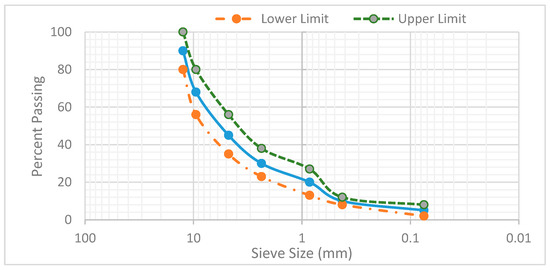
Figure 1.
Aggregate gradation.
Table 1 demonstrates the tested compositions of aggregate gradation with and without bentonite, while Table 2 shows the properties of the aggregates used in this study [28]. XRF was utilized to obtain the chemical compositions of natural aggregate and filler. The XRF analysis showed that CaO was the highest oxide in the limestone aggregate, with 53.52%, followed by SiO2 (3.45%), Fe2O3 (2.12%), and MgO (2.05%).

Table 1.
Amounts of aggregate, filler, and NBC.

Table 2.
Aggregate physical properties.
2.2. Bitumen
Bitumen grade 85/100 from the Jordan Petrol Corporation was used in this study, with 85/100 (0.1 mm) penetration at 25 °C, 100 cm ductility at 25 °C, 1.01 specific gravity at 25 °C, a 49 °C softening point, a 235 °C flash point, a 249 °C fire point, and 99% solubility in trichloroethylene.
2.3. Bentonite
NBC passing US sieve no. 200 from Al-Azraq-Jordan was used in this study, with 2.62 g/cm3 specific gravity, 8% water content, 420 m2/g surface area, and 190% absorption. The chemical composition of NBC is shown in Table 3. The mineral composition of the NBC was obtained by exposure of the clay to XRD analysis. Clay size fraction was separated using Atterberg’s procedure. For clay patterns, results were introduced as peak positions at 2θ and intensity in the form of counts as presented in Figure 2 [28], which also indicates that the NBC used in this study was not pure, comprising smectite-montmorollinite and amounts of illite, kaolinite, quartz, dolomite, and calcite. NBC was added to AC mixtures in small doses to partially replace mineral filler in the aggregate gradation and reduce its swelling behavior.

Table 3.
Chemical analysis of NBC by XRF.
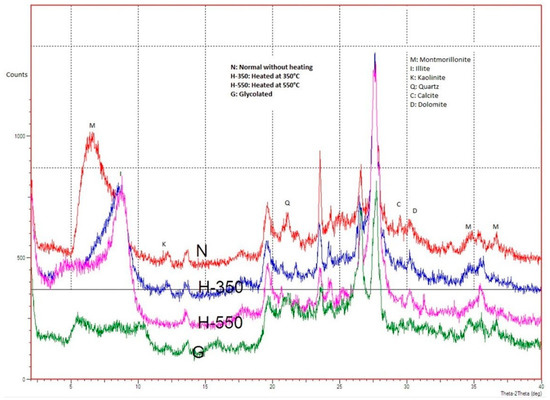
Figure 2.
Representative XRD patterns of oriented samples for Al-Azraq NBC.
3. Test Procedure
3.1. Marshall Test
Following the well-known and well-documented Marshall test procedure for asphalt-mixture stability and flow (ASTM D1559) [30] and air-void and bulk density (ASTM D2726-96) [31] enabled the determination of optimum asphalt content (OAC) that satisfied design requirements under medium traffic conditions. Accordingly, OAC was found to be 5.5% by weight of total asphalt mixture, thus used in sample production. NBC was used in this study because it is available in Jordan and other countries in the region, making it inexpensive to substitute mineral filler of the aggregate in the AC mix by varied amounts of weight: initially 0% for control, then 5%, 10%, 15%, and 20%. Added NBC was a partial substitution of filler; if its maximum case (20% of mineral filler) did not exceed 1% of the total aggregate in the asphalt mixture, then the increase in OAC was negligible. Therefore, for the practicality of the application, OAC was fixed at 5.5% for all samples (all test results presented are from an average of three samples for each asphalt mixture).
Figure 3e shows NBC variations with original and retained stability (RS), which were above the minimum requirement. RS was evaluated after submersion of the specimens in water for 24 h. The submerging procedure comprised immersing AC specimens in a water bath at 25 °C for 24 h to simulate a harsh environment; after that, specimens were inundated in a water bath at 60 °C for 30 min. Stability of modified mixtures decreased with increasing NBC content over 15%, which is consistent with the trend of density (Figure 3a) and VFA (Figure 3d) for the modified AC mixtures with the lowest air voids and VMA (Figure 3b,c), and which might be a result of reduction in adhesion of bitumen to the aggregate and separation of the aggregate in the specimen. The mixing procedure followed in preparing the laboratory AC specimens was exactly as is outlined in a previous study [28].

Figure 3.
Bentonite variation with (a) density, (b) air void, (c) VMA, (d) VFA, and (e) original and retained stability (the green dotted line represents the minimum requirement for stability).
3.2. FT Procedure
Cylindrical AC specimens were exposed to repeated FT cycles in accordance with ASTM C666-Procedure A [32,33]. This procedure was carefully evaluated in terms of determination of FT resistance of asphalt mixtures; the testing procedure was deemed promising and suitable to be used for the purpose of asphalt-mixture FT resistance simulation [34].
In order to conduct FT cycles on AC specimens, each specimen was protected in a plastic zip-lock with the addition of 10 ± 0.5 mL of water before the FT process to prevent loss of moisture. Next, specimens were removed from the bags and placed in a chamber to be subjected to a designated number of FT cycles at a temperature of −18 and 4 °C for repeated cycles of 4 h each.
Specimens were removed from the chamber in a thawed condition at the end of each week, then dried using a towel and tested in addition for damage using an ultra pulse velocity (UPV) test to estimate average weight loss of AC mixtures by measuring the average weight of three specimens for each AC mixture after FT cycles: saturated surface dry (SSD) compared to weight of the control sample before its subjection to the FT cycle. Next, another FT cycle was commenced by placing specimens back into the chamber, after which the process was repeated for a specified number of weeks. Finally, specimens were tested for Marshall stability and flow at the end of week 8.
3.3. Ultrasonic Pulse Velocity (UPV) Measurement
Ultra pulse velocity (UPV) equipment was used to evaluate the damage induced in various AC mixtures under varied FT cycles. Figure 4 shows the experimental setup of the UPV measurement performed in the laboratory for testing AC specimens. The electric pulse was converted into mechanical vibration through a transducer attached to one end face of the asphalt concrete sample. A receiving transducer was placed on the other end face of the sample. The receiving transducer, which received propagating waves, was coupled to an interior timer in the equipment, which instantaneously showed the travel time of the wave [24]. The wave speed was calculated by dividing the length of the specimen by the travel time. It was important to guarantee that a continuous pressure was applied steadily to the transducer to ensure enough contact between transducers and samples and to deliver accurate data. In general, the higher the velocity was, the better the quality of the material was in terms of density, uniformity, homogeneity, and continuity, whereas slower velocities may have indicated AC with several cracks and/or cavities.
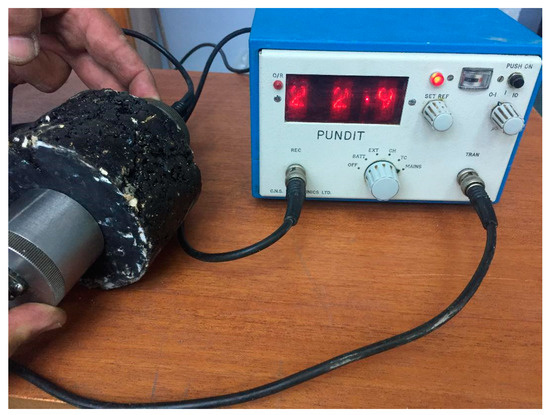
Figure 4.
Ultrasonic pulse velocity measurement.
Damage indices (DI) were then found and used for investigation of the impact of modification of asphalt concrete mixtures with NBC on resistance to freezing and thawing cycles. DI in terms of UPV was calculated using the following equation [24]:
where UPV° is initial ultrasonic pulse velocity and UPVdam is ultrasonic pulse velocity after a certain number of FT cycles [24]. The relationship between DIUPV and additive (NBC) variation, along with various FT cycles, was inspected.
4. Results and Discussions
Based on results obtained by several researchers, bentonite clay could be considered a technically feasible choice as a substitute material to replace natural filler in hot mix asphalt. Considering the global need to ensure well-performing road infrastructures while using environmentally sound construction technologies, the use of bentonite clays as road pavement stabilizers could be of interest to several road investors [35]. Heavy vehicle loads and seasonal temperature changes can impact the rheological and mechanical properties of AC; pavements designed and constructed to withstand medium-heavy traffic require engineered pavement mixtures [36]. Therefore, this research was focused on improving AC mixtures that are used for flexible pavement purposes in roads, highways, and other important AC paving projects in cold regions that undergo high seasonal temperature variations. The main objective in this research was to reduce the damage that occurs within the AC pavement structure in order to minimize the maintenance and management cost of these structures.
The findings of this research revealed that stability of modified AC mixtures rose with increased NBC content. When an improved AC mix was amended by 15% NBC compared to the control sample, a 26% enhancement was recorded. Stability reduced when NBC was increased over 15%, which is in line with the tendency of density in the improved AC mix with NBC. This could be a result of a decrease in adhesion of bitumen to aggregate and detachment of the aggregate in the AC sample.
Figure 5 and Figure 6 show average weight loss and average corrected stability of AC mixtures with different NBC contents after 8 weeks of FT cycles. Both average weight loss and corrected stability rose with the increase of NBC and touched their highest values when NBC was 10%; that corresponded with 6.6% weight loss and 7 kN corrected stability, respectively. Moreover, Figure 6 shows that the stability for the unmodified specimen with 0% NBC dropped drastically after 8 weeks of FT cycles, reaching 4.1 kN, which is below the minimum requirement, as indicated by the dotted green line. However, for 5%, 10%, and 15% modification of NBC, stability results were above the minimum requirement, at 6.1 kN and 7 kN, respectively. At 15% substitution of filler with NBC, the value of corrected stability met minimum requirements for medium traffic conditions after 8 continuous weeks of FT cycles. Increasing the NBC to above 15% resulted in a reduction in asphalt stability, which can be attributed to the ability of NBC to absorb more moisture, resulting in loss of adhesion between asphalt and aggregate and therefore causing reduction of pavement stability.
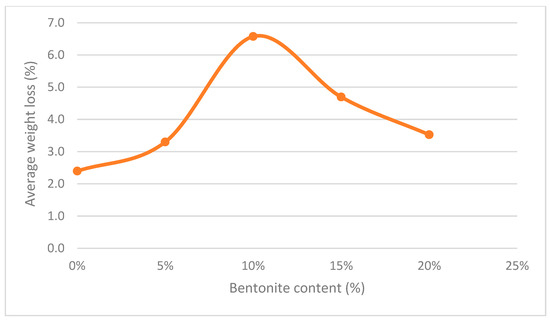
Figure 5.
Average weight loss of AC with bentonite variation after 8 weeks of FT cycles.
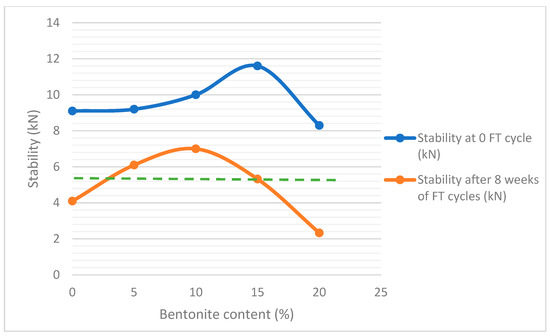
Figure 6.
Average corrected stability (kN) vs bentonite content variation with FT cycles. The green dotted line represents the minimum requirement for stability.
When water entered the AC, the bond between bitumen and aggregate decreased and there was a reduction in adhesion, frequently termed as “stripping.” FT cycles caused more separation and an increase in air void content in asphalt pavement. This, in turn, resulted in different asphalt concrete distresses, such as cracking, flushing, raveling, and bleeding. Replacing a portion of the filler of the AC mix with NBC in a controlled, limited amount resulted in filling of the voids when the bentonite expanded due to increase in moisture and the effect of FT cycles, which resulted in an increase in AC stability. Causes such as frequent temperature variation and FT cycles in winter also produced stiffness reduction of pavement layers, particularly the surface layer that expedited longitudinal and transverse cracks of the top-down type. It also expedited the load-associated fatigue damage by worsening the horizontal tensile stresses at the bottom of the asphalt layer. In fact, cracking and stripping increased with the influence of FT cycles. Environmental stresses are of key importance in affecting pavement construction. These stresses can substantially change the stiffness of asphalt pavement. High temperatures could cause the viscoelastic and thermoplastic asphalt to behave like a viscous fluid, which may lead to rutting. On the other hand, low temperatures (especially temperatures below the freezing point) cause asphalt to act more like an elastic solid that is more susceptible to low temperature cracking. Therefore, loss of durability of asphalt mixtures under freezing and thawing cycles deserves research attention. Consequently, stress and deformation in HMA due to variant thermal expansion and contraction can cause generation of cracks [17].
Figure 7 shows that flow values decreased with an increase of NBC content in modified mixtures when subjected to 8 weeks of freezing and thawing. The flow at 5% and 10% NBC reached 6.2 and 5.5 mm, respectively. Reduction in flow was insignificant with an increase of NBC. Without the FT effect, flow increased with an increase of NBC, from 3.7 mm at 0% NBC to 4.45 mm at 10% NBC; after that, a reduction in flow was recorded with an NBC increase. The test results showed that 5% and 15% NBC contents met asphalt requirements concerning flow and stability for medium traffic conditions before and after being subjected to FT cycles.
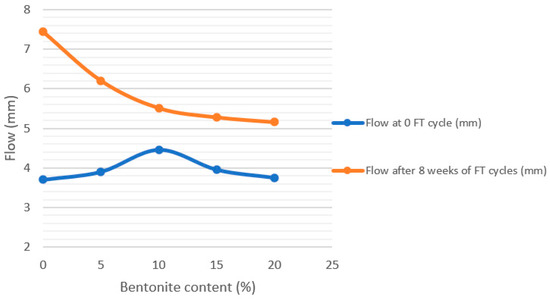
Figure 7.
Flow with bentonite clay variation at different FT cycles.
Figure 8 and Figure 9 represent average velocity UPV (km/s) and the damage index for asphalt mixtures with various bentonite clay contents when subjected to FT cycles.
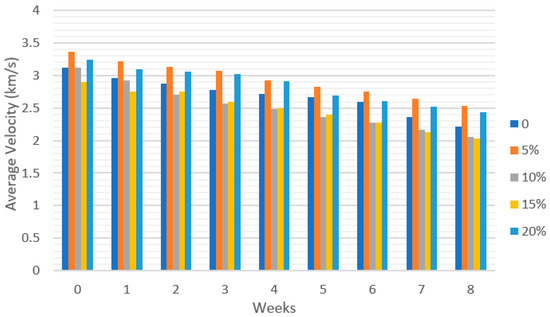
Figure 8.
Average velocity versus FT cycles for AC with bentonite content variation (%).
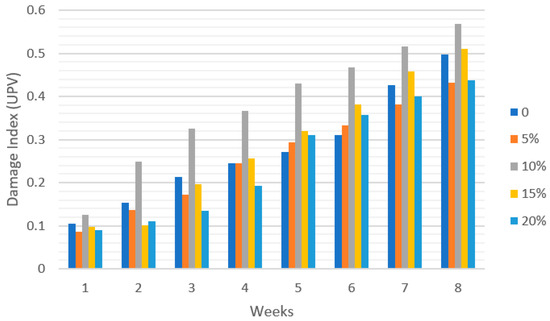
Figure 9.
Damage index versus FT cycles for AC with bentonite content variation (%).
The results displayed that the velocity of nondestructive pulses through asphalt specimens increased by 7.85% at 5% NBC content before application of the FT effect. However, velocity was reduced when specimens were subjected to FT cycles. For instance, after 8 weeks of FT cycles, velocity was reduced by 30% for control/unmodified specimens and 25% for modified mixtures with 5% NBC. In spite of that, when specimens were subjected to 8 weeks of FT effect, the velocity of 5% modified AC mixtures was 15% higher than that of control mixtures. Likewise, the damage index for 5% modified mixtures after 8 weeks of FT cycles was 13% less than that of control samples, indicating that less damage occurred when bentonite clay was used in asphalt-mixture modification. The action of pore pressure due to FT cycles caused the damage and fracturing of microcracks; then small cracks were produced, leading to the appearance of large cracks [37].
Interestingly, weight-loss values after 8 weeks of FT cycles indicated that the least loss was in mixtures modified by 5% bentonite, with 3.3% loss as compared to 4.5%, 6.5%, and 4.7% loss for mixtures modified with 7%, 10%, and 15% NBC, respectively, illustrated by Figure 5. That is why chosen optimum bentonite content was 5%. Moreover, 5% NBC replacement of the mineral filler is a very low amount, as mineral filler forms only 55 g out of 1100 g of the total aggregate; that means the replacement was calculated as 0.05 × 55 = 2.75 g NBC and 52.25 g mineral filler to be added to 770 g coarse aggregate and 275 fine aggregate. This amount of NBC (0.25% of total aggregate) is very low and therefore would not cause expansion of the AC mixture; most NBC particles would be coated by the binder material (bitumen) and eliminate their swelling capacity. It is worth mentioning that the AC weight loss percentage is in line with the findings of Naik et al. (2003) for modified paving stone subjected to FT cycles, which revealed a 0.2% weight loss for all mixtures [38,39,40].
Moreover, in terms of stability for specimens modified with NBC and without FT effect, all specimens passed the minimum requirement; however, after 8 weeks of FT cycles, control specimens and modified specimens with 20% NBC failed the minimum requirement, whereas modified specimens with 5%, 10%, and 15 % of NBC passed the minimum requirement with 6.1, 7, and 5.3 kN, respectively. Therefore, consideration of 5% NBC replacement of the mineral filler of aggregate gradation will result in minimum weight loss, minimum damage, and more stability than required after 8 weeks of FT cycle effect. This is credited to the NBC having a larger surface area than the limestone filler and aggregate, meaning that the latter had less contact area with bitumen: the cause of lower reaction at the interface between limestone filler–aggregate and bitumen than that of NBC and bitumen. Since NBC has a net negative charge, polar fractions in bitumen were adsorbed to the NBC surface and formed a double layer, which resulted in lower tensile strength at the interface between binder and aggregate and a decrease in interlocking of coarse aggregate. Therefore, friction and mechanical interlock will decay between coarse and fine aggregate in AC when NBC content is increased above 15%. This finding helped conclude that increasing NBC content in asphalt mixtures causes a reduction in adhesion between film thickness and coarse aggregate. Notably, size gradation and morphology of the aggregate and its location in the AC have an impact on aggregate movement displacement, aggregate skeleton stability, cracking distribution, and fracture damage of asphalt mixtures at low temperatures [40,41,42].
In order to establish a relationship between influence of NBC content on average velocity and the damage index, a comprehensive analysis was conducted. Linear relationships were established between average velocity and the damage index versus number of weeks for specimens that were subjected to FT cycles at different NBC contents. The coefficient of determination (R2) was used to access quality of linear fit. R2 is known as a numerical value that implies the amount of variance explained by the independent variable(s) in the model. This coefficient of determination was calculated by the following equation:
where R2 = regression model fitting parameter, SSR = sum of squares of errors (residuals), SST = total sum of squares around the mean, Yi = actual dependent variable acquired from experimental work, Yp = predicted dependent variable obtained from the regression model, and Yavg = average value of the actual dependent variable acquired from the experimental study. Developed linear models between average velocity, number of FT weeks, and the damage index versus number of FT weeks at different NBC contents, along with their respective R2 values, are tabulated in Table 4 and Table 5, respectively. Based on the developed models, it can be seen that the established linear models clearly explain variation in dependent variables (average velocity and damage index) at 95% or better. In addition, it was observed analytically that NBC content played a significant role in AC mixture performance under different FT cycles.

Table 4.
Developed linear models between average velocity and number of FT weeks.

Table 5.
Developed linear models between damage index and number of FT weeks.
In general, the performance of asphalt mixtures determines road-pavement performance, especially when pavement is exposed to water through its porous medium; water in porous materials not only causes physical degradation but also carries aggressive agents such as carbon dioxide (CO2), chloride, and sulfates, which can lead to chemical degradation and severely reduce the durability of AC mixtures [43,44]. In addition to that, the FT effect on AC is a significant parameter that contributes to road-pavement damage. Marshall-test and UPV measurements were used to evaluate the impact of FT cycles on AC mixture performance. The two methods were relatively independent and the relationship between the characterization indexes of the two tests was considered to establish more comprehensive consideration of bentonite’s improvement of AC mixture performance. To that end, a single-factor analysis of variance (ANOVA) was carried out; NBC content was used as the factor based on which comparison was conducted versus flow, stability, average velocity, and damage index at 0 weeks of FT cycles and flow, stability, average velocity, and damage index after 8 weeks of rapid and continuous FT cycles. Results are presented in Table 6 and Table 7; Table 6 presents descriptive statistics for the variables used in the ANOVA and Table 7 shows single-factor ANOVA results. It can be statistically seen, as was graphically proven, that bentonite content significantly affected all test indexes on the 0.05 significance level, which supports the motivation of this research. It is of great importance to point out that the p-Value resulted as <0.0001, which implies that NBC has a high influencing effect on asphalt-mixture behavior under FT cycles. This in turn indicates that modifying AC with NBC could help mixtures’ weather-resistance under repeated cycles of FT in addition to wetting and drying.

Table 6.
Single-factor ANOVA results.

Table 7.
Single-factor ANOVA results.
5. Conclusions
Asphalt concrete mixtures made of asphalt (binder) and aggregate are frequently applied in construction of flexible pavements to be used in parking lots, airports, roads, and highways. These pavements are subjected to damage when exposed to FT conditions over different periods of time (FT cycles), which costs governments and private sectors billions of dollars and may result in loss of lives every year in several countries around the world. This research was focused on minimizing this type of damage by using natural bentonite clay in asphalt concrete modification. Based on the experimental results in this study, the following conclusions can be made:
- (1)
- FT cycles reduce weight, stability, and velocity in asphalt concrete mixtures.
- (2)
- Adding 5% of NBC in asphalt concrete mixtures in the form of partial replacement of mineral filler in the aggregate satisfies asphalt-mixture requirements for medium traffic conditions.
- (3)
- Adding 5% of NBC in asphalt concrete mixtures in the form of partial replacement of mineral filler in the aggregate reduces damage caused by 8 continuous weeks of rapid freezing and thawing cycles by 13% as compared to control/unmodified specimens. Additionally, it provides the smallest amount of AC pavement weight loss (0.25%) after 8 continuous weeks of rapid FT cycles (one FT cycle is 4 h).
- (4)
- Modifying AC mixtures by available and inexpensive NBC will lead to reduced maintenance cost.
- (5)
- In the future, improved AC mixtures can be applied in cold regions that suffer the consequences of FT cycles on pavements. They can contribute to reduction of pavement damage, thus prolonging its service life.
Author Contributions
Methodology, M.I.B.B. and R.M.A.; validation, M.A.K.; formal analysis, M.I.B.B.; investigation, M.I.B.B.; data curation, R.M.A.; writing—original draft preparation, M.I.B.B.; writing—review and editing, M.I.B.B.; visualization, M.A.K.; project administration, R.M.A. All authors have read and agreed to the published version of the manuscript.
Funding
The authors would like to acknowledge the support of Al-Zaytoonah University of Jordan for research grant number 17/18/2018-2019.
Institutional Review Board Statement
Not applicable.
Informed Consent Statement
Not applicable.
Data Availability Statement
Not applicable.
Conflicts of Interest
The authors declare no conflict of interest.
References
- Kamiya, S.; Tasaka, S.; Zhang, X.; Dong, D.; Inagaki, N. Compatibilizer Role of Styrene-butadiene-styrene Triblock Copolymer in Asphalt. Polym. J. 2001, 33, 209–213. [Google Scholar] [CrossRef]
- Sun, L.; Xin, X.; Ren, J. Asphalt modification using nano-materials and polymers composite considering high and low temperature performance. Constr. Build. Mater. 2017, 133, 358–366. [Google Scholar] [CrossRef]
- Özen, H. Rutting evaluation of hydrated lime and SBS modified asphalt mixtures for laboratory and field compacted samples. Constr. Build. Mater. 2011, 25, 756–765. [Google Scholar] [CrossRef]
- Shafabakhsh, G.; Taghipoor, M.; Sadegh, N.; Tahami, S.A. Evaluating the effect of additives on improving asphalt mixtures fatigue behaviour. Constr. Build. Mater. 2015, 90, 59–67. [Google Scholar] [CrossRef]
- Button, J.W.; Epps, J.A. Evaluation of Methods of Mixing Lime in Asphalt Pavement Mixtures; Texas Hot Asphalt Pavement Association: Buda, TX, USA, 1983. [Google Scholar]
- Zhang, H.-L.; Su, M.-M.; Zhao, S.-F.; Zhang, Y.-P.; Zhang, Z.-P. High and low temperature properties of nano-particles/polymer modified asphalt. Constr. Build. Mater. 2016, 114, 323–332. [Google Scholar] [CrossRef]
- Iskender, E. Evaluation of mechanical properties of nano-clay modified asphalt mixtures. Measurement 2016, 93, 359–371. [Google Scholar] [CrossRef]
- Yang, J.; Tighe, S. A Review of Advances of Nanotechnology in Asphalt Mixtures. Procedia-Soc. Behav. Sci. 2013, 96, 1269–1276. [Google Scholar] [CrossRef]
- Ziari, H.; Babagoli, R.; Ameri, M.; Akbari, A. Evaluation of fatigue behavior of hot mix asphalt mixtures prepared by bentonite modified bitumen. Constr. Build. Mater. 2014, 68, 685–691. [Google Scholar] [CrossRef]
- Lesueur, D.; Blázquez, M.L.; Garcia, D.A.; Rubio, A.R. On the impact of the filler on the complex modulus of asphalt mixtures. Road Mater. Pavement Des. 2017, 19, 1057–1071. [Google Scholar] [CrossRef]
- Rondón-Quintana, H.A.; Ruge-Cárdenas, J.C.; Bastidas-Martínez, J.G.; Velandia-Castelblanco, M.Y.; Muniz de Farias, M. Use of thermally treated bentonite as filler in hot mix asphalt. J. Mater. Civ. Eng. 2020, 32, 04020070. [Google Scholar] [CrossRef]
- Badeli, S.; Carter, A.; Doré, G. Effect of laboratory compaction on the viscoelastic characteristics of an asphalt mix before and after rapid freeze-thaw cycles. Cold Reg. Sci. Technol. 2018, 146, 98–109. [Google Scholar] [CrossRef]
- Amini, B.; Tehrani, S.S. Simultaneous effects of salted water and water flow on asphalt concrete pavement deterioration under freeze–thaw cycles. Int. J. Pavement Eng. 2014, 15, 383–391. [Google Scholar] [CrossRef]
- ud Dina, I.M.; Mohammad, S.M.; Mohammad, A.F. Effect of freeze-thaw cycles on the properties of asphalt pavements in cold regions: A Review. Transp. Res. Procedia 2020, 48, 3634–3641. [Google Scholar] [CrossRef]
- Chen, X.; Huang, B. Evaluation of moisture damage in hot mix asphalt using simple performance and superpave indirect tensile tests. Constr. Build. Mater. 2008, 22, 1950–1962. [Google Scholar] [CrossRef]
- Feng, D.; Yi, J.; Wang, L.; Wang, D. Impact of Gradation Types on Freeze-Thaw Performance of Asphalt Mixtures in Seasonal Frozen Region. In Proceedings of the Ninth International Conference of Chinese Transportation Professionals (ICCTP), Harbin, China, 5–9 August 2009; pp. 2336–2342. [Google Scholar] [CrossRef]
- Islam, M.R.; Tarefder, R.A. Coefficients of thermal contraction and expansion of asphalt concrete in the laboratory. J. Mater. Civ. Eng. 2015, 27, 04015020. [Google Scholar] [CrossRef]
- Tarefder, R.; Faisal, H.; Barlas, G. Freeze-thaw effects on fatigue LIFE of hot mix asphalt and creep stiffness of asphalt binder. Cold Reg. Sci. Technol. 2018, 153, 197–204. [Google Scholar] [CrossRef]
- Ma, B.; Si, W.; Zhu, D.-P.; Wang, H.-N. Applying Method of Moments to Model the Reliability of Deteriorating Performance to Asphalt Pavement under Freeze-Thaw Cycles in Cold Regions. J. Mater. Civ. Eng. 2015, 27, 04014103. [Google Scholar] [CrossRef]
- Feng, D.; Yi, J.; Wang, D.; Chen, L. Impact of salt and freeze–thaw cycles on performance of asphalt mixtures in coastal frozen region of China. Cold Reg. Sci. Technol. 2010, 62, 34–41. [Google Scholar] [CrossRef]
- Goh, S.W.; Akin, M.; You, Z.; Shi, X. Effect of deicing solutions on the tensile strength of micro- or nano-modified asphalt mixture. Constr. Build. Mater. 2011, 25, 195–200. [Google Scholar] [CrossRef]
- Huang, Y.H. Pavement Analysis and Design; Pearson Prentice Hall: Hall, KY, USA, 2004. [Google Scholar]
- Si, W.; Ma, B.; Wang, H.-N.; Li, N.; Hu, J. Analysis of Compressive Characteristics of Asphalt Mixture under Freeze-Thaw Cycles in Cold Plateau Regions. J. Highw. Transp. Res. Dev. 2013, 7, 17–22. [Google Scholar] [CrossRef]
- Abendeh, R.; Ramadan, K.; Haddad, R.H.; Bani Baker, M. Freezing Thawing Resistance of Concrete Incorporating Glass Waste. J. Mater. Sci. Res. 2015, 4, 19. [Google Scholar] [CrossRef][Green Version]
- Xu, H.; Guo, W.; Tan, Y. Internal structure evolution of asphalt mixtures during freeze–thaw cycles. Mater. Des. 2015, 86, 436–446. [Google Scholar] [CrossRef]
- Özgan, E.; Serin, S. Investigation of certain engineering characteristics of asphalt concrete exposed to freeze–thaw cycles. Cold Reg. Sci. Technol. 2013, 85, 131–136. [Google Scholar] [CrossRef]
- Xu, H.; Guo, W.; Tan, Y. Permeability of asphalt mixtures exposed to freeze–thaw cycles. Cold Reg. Sci. Technol. 2016, 123, 99–106. [Google Scholar] [CrossRef]
- Baker, M.I.B.; Abendeh, R.M.; Obaidat, T.A.S. Employing Natural Bentonite Clay as Partial Replacement of Mineral Filler in Asphalt Mixtures. J. Mater. Civ. Eng. 2018, 30, 04018167. [Google Scholar] [CrossRef]
- The Ministry of Housing and Public Works-Jordan. The Jordanian Ministry of Public Works and Housing Specifications; MPWH: Amman, Jordan, 2010.
- ASTM D1559; Test Method for Resistance of Plastic Flow of Bituminous Mixtures Using Marshall Apparatus. American Society for Testing and Materials: Philadelphia, PA, USA, 1998.
- ASTM D2726-96; Standard Test Method for Bulk Specific Gravity and Density of Non-Absorptive Compacted Bituminous Mixtures. American Society for Testing and Materials: Philadelphia, PA, USA, 2010.
- ASTM C666; Standard Test Method for Resistance of Concrete to Rapid Freezing and Thawing. American Society for Testing and Materials: Philadelphia, PA, USA, 2015.
- Abendeh, R.M.; Bani Baker, M.I. Using Steel Slag Aggregate to Strengthen Self-Compacting Concrete Durability. In Structures and Buildings; ICE Publishing: London, UK, 2021; pp. 1–15. [Google Scholar] [CrossRef]
- Ho, C.-H.; Linares, C.P.M.; Shan, J.; Almonnieay, A. Material Testing Apparatus and Procedures for Evaluating Freeze-Thaw Resistance of Asphalt Concrete Mixtures. Adv. Civ. Eng. Mater. 2017, 6, 20170005. [Google Scholar] [CrossRef]
- Barbieri, D.M.; Lou, B.; Dyke, R.J.; Chen, H.; Zhao, P.; Memon, S.A.; Hoff, I. Dataset regarding calcium bentonite and sodium bentonite as stabilizers for roads unbound. Data Brief 2022, 41, 107898. [Google Scholar] [CrossRef]
- Johnson, T.; Hashemian, L.; Patra, S.; Shabani, A. Application of nanoclay materials in asphalt pavements. Innovations in pavement management, Engineering Technology Session. In Proceedings of the TAC-ITS Canada Joint Conference, Halifax, NS, Canada, 22–25 September 2019. [Google Scholar]
- Xue, Y.; Ranjith, P.; Chen, Y.; Cai, C.; Gao, F.; Liu, X. Nonlinear mechanical characteristics and damage constitutive model of coal under CO2 adsorption during geological sequestration. Fuel 2023, 331, 125690. [Google Scholar] [CrossRef]
- Naik, T.R.; Kraus, R.N.; Chun, Y.-M.; Ramme, B.W.; Singh, S.S. Properties of Field Manufactured Cast-Concrete Products Utilizing Recycled Materials. J. Mater. Civ. Eng. 2003, 15, 400–407. [Google Scholar] [CrossRef]
- Siddique, R.; Singh, G. Utilization of waste foundry sand (WFS) in concrete manufacturing. Resour. Conserv. Recycl. 2011, 55, 885–892. [Google Scholar] [CrossRef]
- Baker, M.B.; Abendeh, R. Improving asphalt concrete resistance to rapid freeze–thaw effect using HIPS polymer. Emerg. Mater. Res. 2022, 11, 356–366. [Google Scholar] [CrossRef]
- Zhu, X.; Qian, G.; Yu, H.; Yao, D.; Shi, C.; Zhang, C. Evaluation of coarse aggregate movement and contact unbalanced force during asphalt mixture compaction process based on discrete element method. Constr. Build. Mater. 2022, 328, 127004. [Google Scholar] [CrossRef]
- Wei, H.; Li, J.; Wang, F.; Zheng, J.; Tao, Y.; Zhang, Y. Numerical investigation on fracture evolution of asphalt mixture compared with acoustic emission. Int. J. Pavement Eng. 2021, 23, 3481–3491. [Google Scholar] [CrossRef]
- Nie, G.; Cai, X.; Huang, W.; Hassan, H.M.Z.; Chen, S.; Zhang, Q.; Xie, J.; Wu, K. Designing of an anti-rutting and High Ductility Asphalt Mixture based on mortar performance. Constr. Build. Mater. 2021, 316, 125837. [Google Scholar] [CrossRef]
- Alamayreh, M.; Alahmer, A.; Bazlamit, S.; Younes, M. Energy analysis and refrigerant replacement in pre-cooling concrete system in massive concrete structures. In Proceedings of the 11th International Conference on Engineering, Project, and Production Management, Berlin, Germany, 20–21 September 2021; p. 14. [Google Scholar]
Publisher’s Note: MDPI stays neutral with regard to jurisdictional claims in published maps and institutional affiliations. |
© 2022 by the authors. Licensee MDPI, Basel, Switzerland. This article is an open access article distributed under the terms and conditions of the Creative Commons Attribution (CC BY) license (https://creativecommons.org/licenses/by/4.0/).